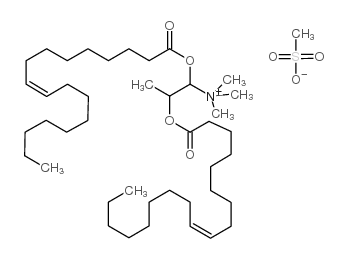DOTAP Transfection Reagent

DOTAP Transfection Reagent structure
|
Common Name | DOTAP Transfection Reagent | ||
|---|---|---|---|---|
| CAS Number | 144189-73-1 | Molecular Weight | 758.18700 | |
| Density | N/A | Boiling Point | N/A | |
| Molecular Formula | C43H83NO7S | Melting Point | N/A | |
| MSDS | USA | Flash Point | N/A | |
|
BBS4 directly affects proliferation and differentiation of adipocytes.
Cell. Mol. Life Sci. 71(17) , 3381-92, (2014) BBS4 is one of several proteins whose defects cause Bardet-Biedl syndrome (BBS), a multi-systemic disorder, manifesting with marked obesity. BBS4 polymorphisms have been associated with common non-syndromic morbid obesity. BBS4 obesity molecular mechanisms, a... |
|
|
TRPV4 channel activity is modulated by direct interaction of the ankyrin domain to PI(4,5)P₂.
Nat. Commun. 5 , 4994, (2014) Mutations in the ankyrin repeat domain (ARD) of TRPV4 are responsible for several channelopathies, including Charcot-Marie-Tooth disease type 2C and congenital distal and scapuloperoneal spinal muscular atrophy. However, the molecular pathogenesis mediated by... |
|
|
H89 enhances the sensitivity of cancer cells to glyceryl trinitrate through a purinergic receptor-dependent pathway.
Oncotarget 6(9) , 6877-86, (2015) High doses of the organic nitrate glyceryl trinitrate (GTN), a nitric oxide (NO) donor, are known to trigger apoptosis in human cancer cells. Here, we show that such a cytotoxic effect can be obtained with subtoxic concentrations of GTN when combined with H89... |
|
|
Sp1 sites in the noncoding control region of BK polyomavirus are key regulators of bidirectional viral early and late gene expression.
J. Virol. 89(6) , 3396-411, (2015) In kidney transplant patients with BK polyomavirus (BKPyV) nephropathy, viral variants arise bearing rearranged noncoding control regions (rr-NCCRs) that increase viral early gene expression, replicative fitness, and cytopathology. rr-NCCRs result from variou... |
|
|
SSX2 is a novel DNA-binding protein that antagonizes polycomb group body formation and gene repression.
Nucleic Acids Res. 42(18) , 11433-46, (2014) Polycomb group (PcG) complexes regulate cellular identity through epigenetic programming of chromatin. Here, we show that SSX2, a germline-specific protein ectopically expressed in melanoma and other types of human cancers, is a chromatin-associated protein t... |
|
|
HBP1 promoter methylation augments the oncogenic β-catenin to correlate with prognosis in NSCLC.
J. Cell. Mol. Med. 18(9) , 1752-61, (2014) β-catenin nuclear accumulation is frequently identified in human non-small cell lung cancer (NSCLC). The HMG-box transcription factor 1 (HBP1) is a known repressor of β-catenin transactivation. However, the role of HBP1 in relation to β-catenin nuclear accumu... |
|
|
EGFR signaling downstream of EGF regulates migration, invasion, and MMP secretion of immortalized cells derived from human ameloblastoma.
Tumour Biol. 35(11) , 11107-20, (2014) Ameloblastoma is an odontogenic tumor characterized by local invasiveness and frequent recurrence. The surrounding stroma, composed of different cell types and extracellular matrix (ECM), may influence ameloblastoma invasive behavior. Furthermore, tumor and s... |
|
|
Nox2-dependent glutathionylation of endothelial NOS leads to uncoupled superoxide production and endothelial barrier dysfunction in acute lung injury.
Am. J. Physiol. Lung Cell. Mol. Physiol. 307(12) , L987-97, (2014) Microvascular barrier integrity is dependent on bioavailable nitric oxide (NO) produced locally by endothelial NO synthase (eNOS). Under conditions of limited substrate or cofactor availability or by enzymatic modification, eNOS may become uncoupled, producin... |
|
|
Antisense oligonucleotides capable of promoting specific target mRNA reduction via competing RNase H1-dependent and independent mechanisms.
PLoS ONE 9(10) , e108625, (2014) Antisense oligonucleotides (ASOs) are most commonly designed to reduce targeted RNA via RNase H1-dependent degradation. In this paper we demonstrate that cellular proteins can compete for sites targeted by RNase H1-dependent ASOs. We further show that some AS... |
|
|
A precisely substituted benzopyran targets androgen refractory prostate cancer cells through selective modulation of estrogen receptors.
Toxicol. Appl. Pharmacol. 283(3) , 187-97, (2015) Dietary consumption of phytoestrogens like genistein has been linked with lower incidence of prostate cancer. The estradiol-like benzopyran core of genistein confers estrogen receptor-β (ER-β) selectivity that imparts weak anti-proliferative activity against ... |